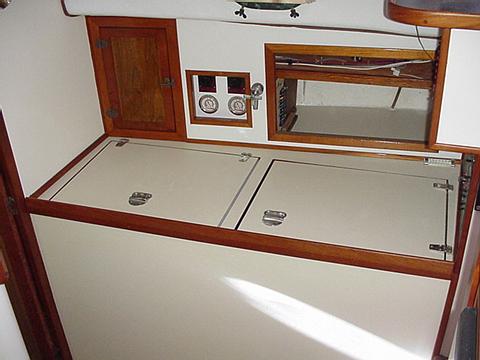Chain Plate info for the CSY Owners Forum
Hello gang,
Saw some discussion on the Round Chain Plate design I had come up with in the latter 90's. My design, was a take off of a design by Tillerson Pearson and Steve Dashew for the manufacture of 54'-62' Deerfoot Yachts. You can see their design (round but 10 bolts) in the Dashew's Cruising Encyclopedia page 582. For manufacturing it made a lot of sense, as you could make All chain plates the same and just rotate the tang in the direction needed. Installation was easy, just drill and insert the center bolt first, the rotate the tang in the direction of the rigging wire, or attach it. Drill the remaining holes, insert bolts and so on. Easy. CSY used 3/8" tang material (304 SS) welded to a 1/4" triangular backing plate, with 6 bolts. I used solid 1/2" (316 grade SS) with no welds and 8 "Counter Sunk" socket head bolts also made from 316 grade stainless steel. Dashew's plates used 3 hole tangs, so were quite wide. This also gives immense strength to the tang, due to the added width.
I made all my tangs 4" wide with double holes. One for the rigging and the other hole for the attachment of a shackle if I wished, so as to be able to take a lead somewhere else in odd or emergency situations. Plates were cut on a CNC machine, but later ones were made at a local machine shop without the aid of a CNC machine for other owners and looked perfect. Note, countersinking the heads, offers crevice corrosion protection. Many Hex Head bolts used on CSY's failed. Heads would snap off because water/moisture gains access under the head and over time, crevice corrosion causes the stainless to fail.
Here's a few photos below, taken in 2000/2001.
Note, back in the day, I payed about $300/Plate for material, cutting, final polishing(I did the initial polishing with grits up to 600 grit). the bolts alone back then were $9.69 each, plus Aircraft 316 Nylock nuts and 1/2" large flat washers for the interior. I ordered 100 as my Pilothouse was a ketch requiring more plates/bolts.
Important I feel is that, with heavier material and double width tangs (4" double vs 2" single) the 1/2 thick material vs 3/8's as well as 8 bolts rather than 6, that the plates should last at least a 1/2 century probably more! This method makes Chain Plates totally trustworthy for many, many decades.
Hope this helps anyone engaged in their chain plate project.
Saw some discussion on the Round Chain Plate design I had come up with in the latter 90's. My design, was a take off of a design by Tillerson Pearson and Steve Dashew for the manufacture of 54'-62' Deerfoot Yachts. You can see their design (round but 10 bolts) in the Dashew's Cruising Encyclopedia page 582. For manufacturing it made a lot of sense, as you could make All chain plates the same and just rotate the tang in the direction needed. Installation was easy, just drill and insert the center bolt first, the rotate the tang in the direction of the rigging wire, or attach it. Drill the remaining holes, insert bolts and so on. Easy. CSY used 3/8" tang material (304 SS) welded to a 1/4" triangular backing plate, with 6 bolts. I used solid 1/2" (316 grade SS) with no welds and 8 "Counter Sunk" socket head bolts also made from 316 grade stainless steel. Dashew's plates used 3 hole tangs, so were quite wide. This also gives immense strength to the tang, due to the added width.
I made all my tangs 4" wide with double holes. One for the rigging and the other hole for the attachment of a shackle if I wished, so as to be able to take a lead somewhere else in odd or emergency situations. Plates were cut on a CNC machine, but later ones were made at a local machine shop without the aid of a CNC machine for other owners and looked perfect. Note, countersinking the heads, offers crevice corrosion protection. Many Hex Head bolts used on CSY's failed. Heads would snap off because water/moisture gains access under the head and over time, crevice corrosion causes the stainless to fail.
Here's a few photos below, taken in 2000/2001.
Note, back in the day, I payed about $300/Plate for material, cutting, final polishing(I did the initial polishing with grits up to 600 grit). the bolts alone back then were $9.69 each, plus Aircraft 316 Nylock nuts and 1/2" large flat washers for the interior. I ordered 100 as my Pilothouse was a ketch requiring more plates/bolts.
Important I feel is that, with heavier material and double width tangs (4" double vs 2" single) the 1/2 thick material vs 3/8's as well as 8 bolts rather than 6, that the plates should last at least a 1/2 century probably more! This method makes Chain Plates totally trustworthy for many, many decades.
Hope this helps anyone engaged in their chain plate project.



















No comments:
Post a Comment